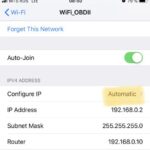Understanding the Obd2 Readiness Drive Cycle is crucial for passing emissions tests and ensuring your vehicle is running smoothly. This guide provides a step-by-step walkthrough of the process, common questions, and troubleshooting tips.
The OBD2 readiness drive cycle allows your vehicle’s onboard computer, the Powertrain Control Module (PCM), to perform self-diagnostics and verify that all emissions-related components are functioning correctly. Completing this cycle is essential after repairs or clearing diagnostic trouble codes (DTCs) to ensure your car is ready for an emissions test.
What is an OBD2 Readiness Drive Cycle?
The OBD2 readiness drive cycle is a series of specific driving conditions that must be met to allow the PCM to run its emissions tests. These tests monitor various components like the catalytic converter, oxygen sensors, evaporative emissions system (EVAP), and exhaust gas recirculation (EGR) system. If a component fails its test, a DTC is stored, and the corresponding readiness monitor will not be set to “Ready” or “Complete”.
How to Perform an OBD2 Readiness Drive Cycle
While specific drive cycles can vary slightly between vehicle manufacturers, here’s a general outline of the process:
-
Clear DTCs: Use an OBD2 scanner to clear any existing diagnostic trouble codes.
-
Fuel Level: Ensure your fuel tank is between one-quarter and three-quarters full.
-
Battery and Alternator: Verify your battery and alternator are in good working condition. Avoid jump-starting the vehicle before the drive cycle.
-
Cold Start: Let your vehicle sit for at least eight hours without starting the engine or opening the doors. This ensures a proper cold start.
-
Idle: After the cold soak, start the engine and let it idle in park or neutral for two to three minutes.
-
Accessory Load: Turn on the headlights, heater, and defroster for at least two minutes.
-
City Driving: Drive at varying speeds between 25 and 45 mph, including several stops and accelerations.
-
Highway Driving: Reach and maintain a steady speed of 55-60 mph for at least five minutes, preferably using cruise control.
-
Deceleration: Decelerate gradually without braking heavily, allowing the vehicle to coast down to a stop if possible.
-
Idle: After completing the driving portion, let the engine idle for one to two minutes.
Checking OBD2 Readiness Monitors
After completing the drive cycle, use an OBD2 scanner to check the status of the readiness monitors. Each monitor will indicate “Ready” or “Complete” if the corresponding system has passed its self-test. If a monitor remains “Not Ready” or “Incomplete”, you may need to repeat the drive cycle or troubleshoot potential issues.
Troubleshooting and Frequently Asked Questions
- How long does an OBD2 readiness drive cycle take? The driving portion typically takes around 20-30 minutes, but the eight-hour cold soak is essential.
- What if a monitor won’t set to “Ready”? This indicates a potential problem with the corresponding system. Further diagnosis is required.
- Can I use a generic OBD2 drive cycle? While the general outline provided here works for many vehicles, consulting your vehicle’s specific repair manual for the recommended drive cycle is best.
Understanding and performing the OBD2 readiness drive cycle is crucial for maintaining your vehicle’s emissions system and ensuring a smooth emissions test. By following the steps outlined in this guide, you can help ensure your vehicle is running efficiently and in compliance with environmental regulations.

